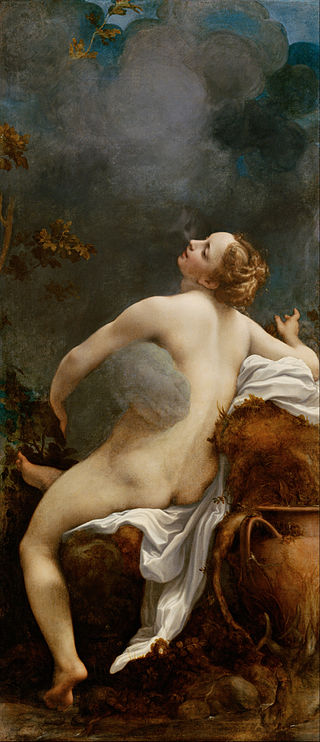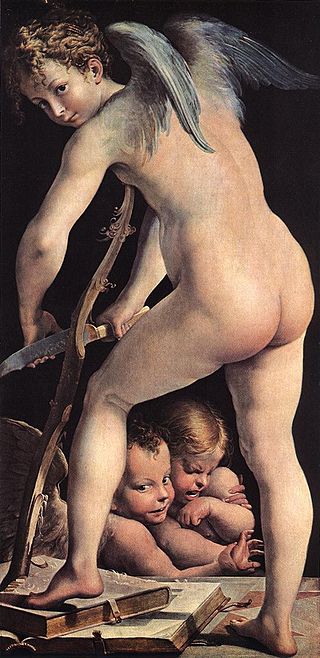
The Rape of the Sabine Women, also known as the Abduction of the Sabine Women or the Kidnapping of the Sabine Women, was an incident in Roman mythology in which the men of Rome committed a mass abduction of young women from the other cities in the region. It has been a frequent subject of painters and sculptors, particularly during the Renaissance and post-Renaissance eras.

Jupiter and Io is a painting by the Italian High Renaissance artist Antonio da Correggio around 1530. It now hangs in the Kunsthistorisches Museum in Vienna, Austria.

The Rape of Persephone, or Abduction of Persephone, is a classical mythological subject in Western art, depicting the abduction of Persephone by Hades. This then resulted in the myth surrounding the creation of the seasons, as Demeter mourned the time that Persephone spent in the Underworld with her husband. In the context of the subject, the word "Rape" refers to the traditional translation of the Latin raptus which refers to bride kidnapping rather than sexual violence.

Damiano Mazza was an Italian Renaissance artist. He lived in the Venetian city of Padua, 40 km west of Venice. It is known that he studied under Titian.
Ganymede most commonly refers to:

In Greek mythology, Ganymede or Ganymedes is a divine hero whose homeland was Troy. Homer describes Ganymede as the most beautiful of mortals and tells the story of how he was abducted by the gods to serve as Zeus's cup-bearer in Olympus.
[Ganymedes] was the loveliest born of the race of mortals, and therefore
the gods caught him away to themselves, to be Zeus' wine-pourer,
for the sake of his beauty, so he might be among the immortals.

Sir Peter Paul Rubens was a Flemish artist and diplomat from the Duchy of Brabant in the Southern Netherlands. He is considered the most influential artist of the Flemish Baroque tradition. Rubens's highly charged compositions reference erudite aspects of classical and Christian history. His unique and immensely popular Baroque style emphasized movement, colour, and sensuality, which followed the immediate, dramatic artistic style promoted in the Counter-Reformation. Rubens was a painter producing altarpieces, portraits, landscapes, and history paintings of mythological and allegorical subjects. He was also a prolific designer of cartoons for the Flemish tapestry workshops and of frontispieces for the publishers in Antwerp.

Ganymede Abducted by the Eagle is a painting by the Italian late Renaissance artist Antonio da Correggio. It is housed in the Kunsthistorisches Museum, Vienna, Austria.

Cupid Making His Bow is a painting by the Italian late Renaissance artist Parmigianino. It is housed in the Kunsthistorisches Museum, Vienna, Austria.
Tribute Money may refer to:

The Rape of the Daughters of Leucippus is a 1618 painting by Peter Paul Rubens and Jan Wildens. It is displayed at the Alte Pinakothek in Munich.

The Rape of Ganymede is a painting by the Flemish Baroque painter Peter Paul Rubens produced between 1636 and 1638 painting for the Spanish king Philip IV of Spain's hunting lodge. The painting is based on a story recounted in classical poet Ovid´s Metamorphoses. It depicts the moment when the Roman supreme god Jupiter disguised as an eagle catches the young shepherd Ganymede and lifts him into the air. It is in the collection of the Museo del Prado in Madrid. The dramatic scene gave Rubens ample opportunity to show his skill in depicting a lively scene and the nude.

The Rape of the Sabine Women is a painting by Peter Paul Rubens. It is now in the Belfius Collection. It was commissioned by Philip IV of Spain in 1639 but was still incomplete on Rubens' death a year later. It was completed by the Brussels painter Gaspar de Crayer.
The Rape of Europa was a mythological event involving Europa. It may also refer to:

In Greek mythology, Orithyia or Oreithyia was an Athenian princess who was raped by Boreas, the north wind, and gave birth to the twin Boreads, Zetes and Calaïs.
Virgin and Child is a representation in art of Mary with her child Jesus.
The Rape of the Sabine Women was an incident in Roman mythology.

The Rape of Ganymede is a painting by Damiano Mazza in the National Gallery, London. The artist's best-known painting, it depicts the legendary account of an eagle kidnapping the handsome Ganymede and taking him to Mount Olympus to serve both as Jupiter's lover and as cupbearer to the gods.
This page is based on this
Wikipedia article Text is available under the
CC BY-SA 4.0 license; additional terms may apply.
Images, videos and audio are available under their respective licenses.











